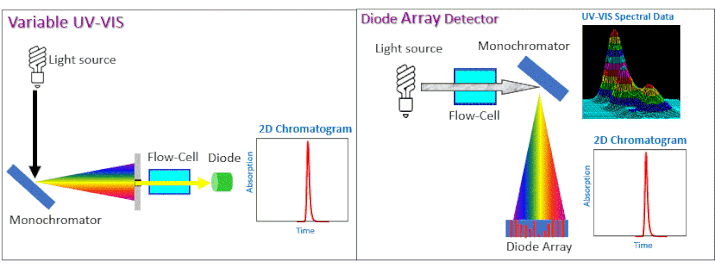The topic of this article may not meet Wikipedia's general notability guideline .(November 2019) |
An ultraviolet detector (also known as UV detector or UV-Vis detector) [1] [2] is a type of non-destructive chromatography detector which measures the amount of ultraviolet or visible light absorbed by components of the mixture being eluted off the chromatography column. They are often used as detectors for high-performance liquid chromatography. [3]
The vast majority of liquid chromatographic systems are equipped with ultraviolet (UV) absorption detectors. The most common UV-Vis detectors used are variable wavelength detectors (VWD), photo diode array detectors (PDA), and diode array detectors (DAD). [4] Variable wavelength detectors decide in advance which wavelength is needed for the detection. Its absorbance as function of time is collected in a graphic format called a chromatogram. [5]
As can be seen in Figure 1, these detectors have a light source, a dispersion element that is a diffraction grating or prism, a flow cell, to where the sample arrives directly from the chromatographic column, an optical bench of lenses and mirrors, and a diode that receives the light coming from the optical system and translates it into a signal proportional to light intensity. When the user selects a wavelength for the detector, the optical system rotates the grating or prism in the space, so that the desired wavelength passes through optical system, then the flow cell and reaches the diode. The UV/Vis detector then produces a chromatogram as a two-dimensional (2D) output. This output plots time on the x-axis and response in absorbance units (AU) on the y-axis. The chromatogram is then analyzed by integrating the peaks curves to get their area, then getting their retention time (RT) from the peak maximum to identify them, and then perform quantitative analysis, by comparing their area to those of samples whose concentrations are known, i.e, standards.
